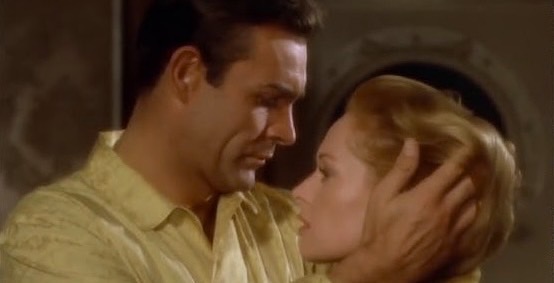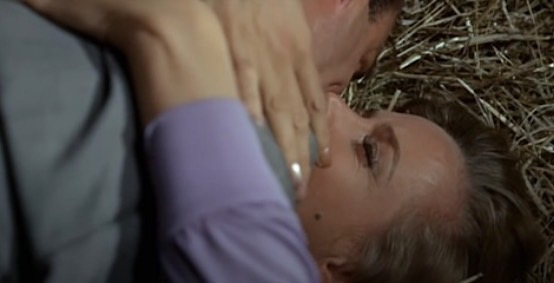Cinema Sins for 100, Alex
My first encounter with a Bond film in a movie theater was seeing Alfred Hitchcock’s Marnie in 1964. I was either 13 or would soon turn 13. I knew there was such a thing as a Bond film, had read Fleming’s Goldfinger and had seen a photo spread of publicity stills for From Russia With Love in a popular magazine (probably Look).
While I technically knew the difference between a Hitchcock film and a Bond film, after finally seeing my first genuine Bond film I couldn’t shake the sense that I had already seen one.
Sean Connery seemed just as stylishly dressed and immaculately groomed in Marnie as he would be several months later in Goldfinger, and really did seem to be playing approximately the same role twice.
He is on the trail of puzzling cases in both films, and plays games with his chief opponents. In both, he works out of a home base which includes a patriarchal figure, a flirtatious female, and an expert with whom he maintains a contentious relationship. “M,” Moneypenny and “Q” from Goldfinger are neatly balanced by Mr. Rutland (Alan Napier), sister-in-law Lil (Diane Baker), and banker “Cousin Bob” (Bob Sweeney) in Marnie.
And, oh yes, Connery plays a man who indulges in nonconsensual intimacy in both films.
According to screenwriter Jay Presson Alan, the controversial and truly disturbing marital assault which occurs in Marnie was the main attraction for Hitchcock, perhaps his sole reason for wanting to direct the film. When the project’s first scribe, Evan Hunter, tried to eliminate the problematic scene altogether, he was promptly sacked and replaced with Ms. Alan.
After screening prints of Dr. No and From Russia With Love, Hitchcock and Alan agreed on casting Sean Connery to play the man who blackmails a frigid, compulsive thief (Tippi Hedren) into marrying him. Connery’s solidifying identification with 007 was played up in studio press releases concerning the actor’s addition to the cast of Marnie.
The Master of Suspense, Alfred Hitchcock, announced he's getting together with the master of counter spies, James Bond-or at least with the man who plays Bond on the screen, Scotland's Sean Connery…
Hitchcock said he was going to present a new Connery—instead of being the much pursued bachelor, he'll play an understanding husband. 'It will be a real switch,' a Hitchcock representative explained after the announcement. 'He may not shoot anybody through the whole picture.'
Despite what the announcement claimed, the chief discernible difference between the Connery of the Bond saga and the one in Hitchcock’s Marnie is a matter of perhaps a millimeter of visible eyebrows.

It seems that Hitchcock deliberately cast the man known for the role of James Bond as the ultra-masculine predator in Marnie, to underline the darker side of cinema’s newest hero.
However, the director couldn’t resist lightening the mood with a sight gag, panning the camera away during Mark’s savage assault to frame a shot of the porthole in the couple’s cabin. It’s a disquieting callback to the final scene of North by Northwest, where the train carrying a honeymooning couple roars into a tunnel. Are viewers supposed to chuckle when they see the porthole or merely be relieved at the opportunity to look away?
Hitchcock also takes some of the edge off Marnie’s suicide attempt the following morning by giving a resuscitated Tippi Hedren the best quip in the film. When Connery asks why she tried to drown herself in the pool instead of jumping over the side of the ship, she replies, “The idea was to kill myself, not feed the damn fish.” Again there’s a chuckle, but perhaps a nervous one.
After completing his final scene on Marnie, Connery enjoyed a brief celebration with the cast and crew before rushing off to join the production team on the set of Goldfinger, his fourth film in the past twelve months.

Connery’s character would soon have to force himself on the struggling body of another attractive young woman as she futilely tries to fight off his carnal advances.
Since no such scene exists in Fleming’s novel, I’m tempted to wonder if the tussle in Goldfinger’s barn with Honor Blackman as Pussy Galore, was suggested by its disturbing counterpart in Marnie. Though Ms. Galore protests that she’s “strictly the outdoor type,” as soon as Connery’s lips press down on hers, Blackman’s struggling arms suddenly encircle his shoulders and she practically inhales him.
When John Barry’s playful underscore for the scene builds to a romantic swell, as if the film had suddenly turned into a parody of From Here to Eternity, audiences guffawed. It was not only a perfect embodiment of egotistical male fantasy, but a logical extension of the film’s fairytale milieu.
The mischievous imp’s golden spell was broken, not with a kiss, but a roll in the hay.
Unfortunately, the lesson learned by the production team was that audiences would let Connery’s Bond get away with anything.